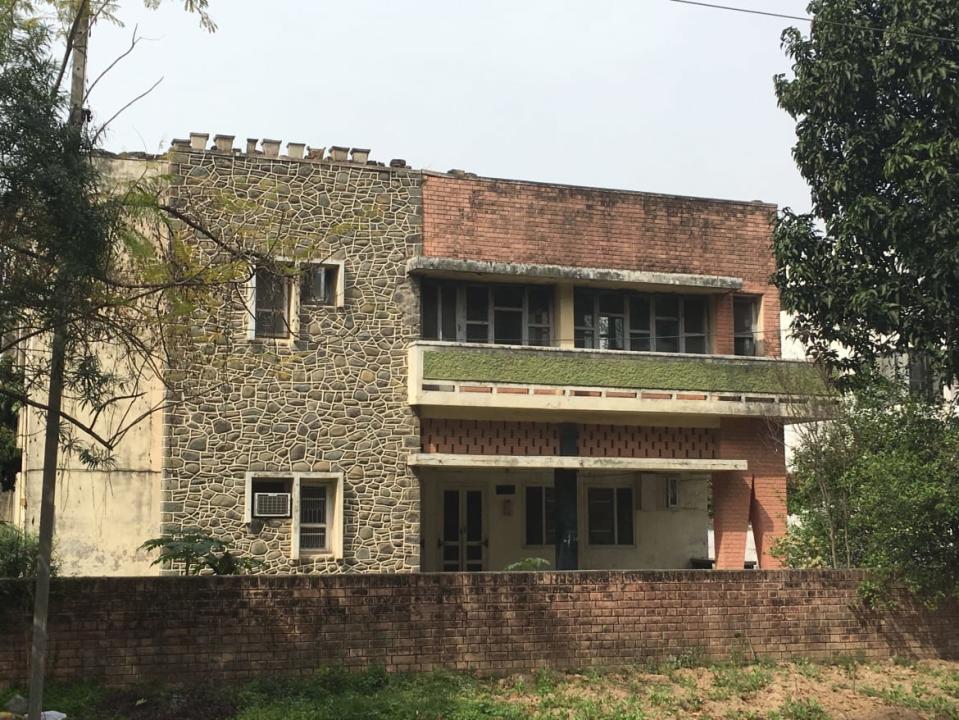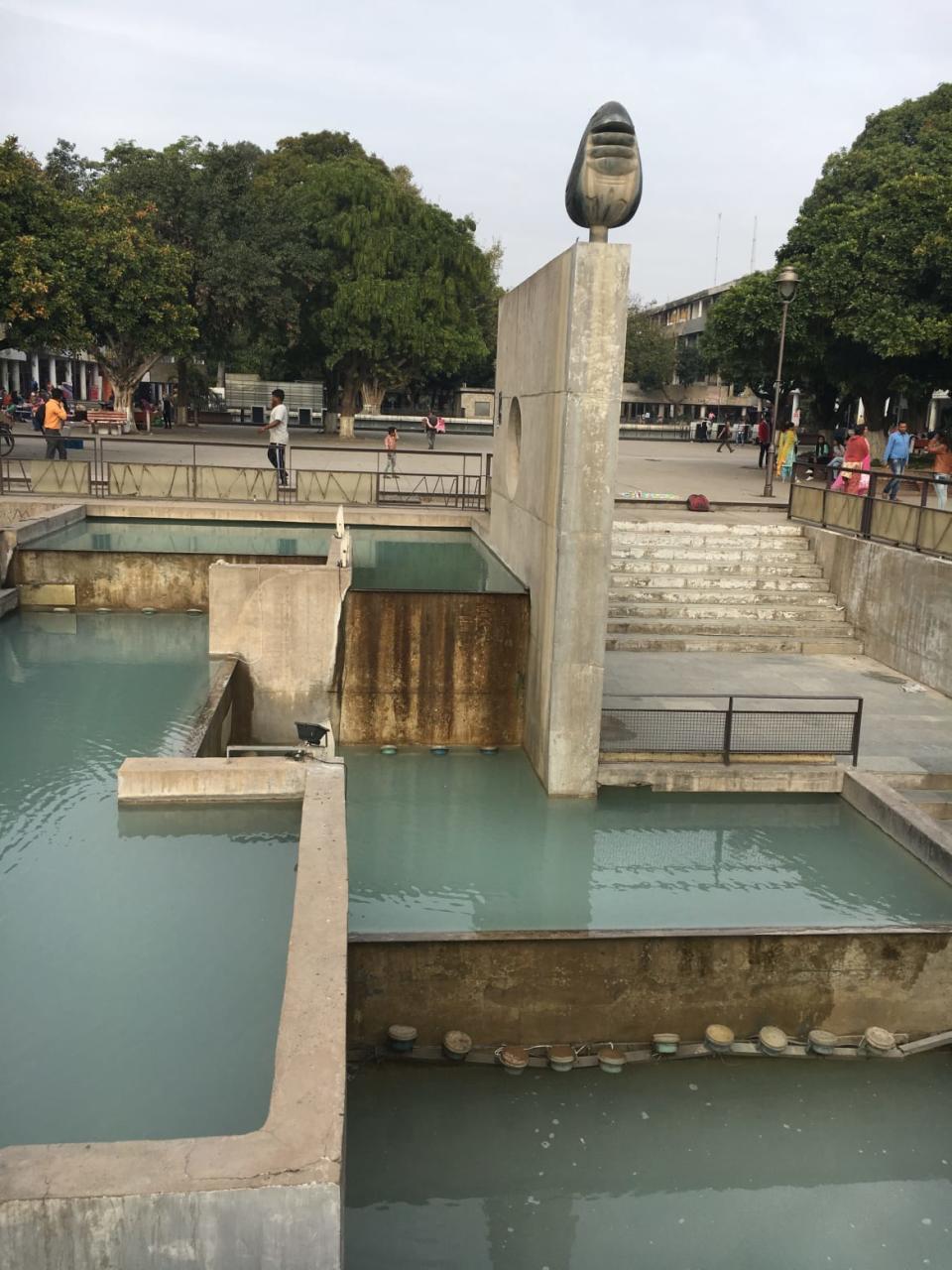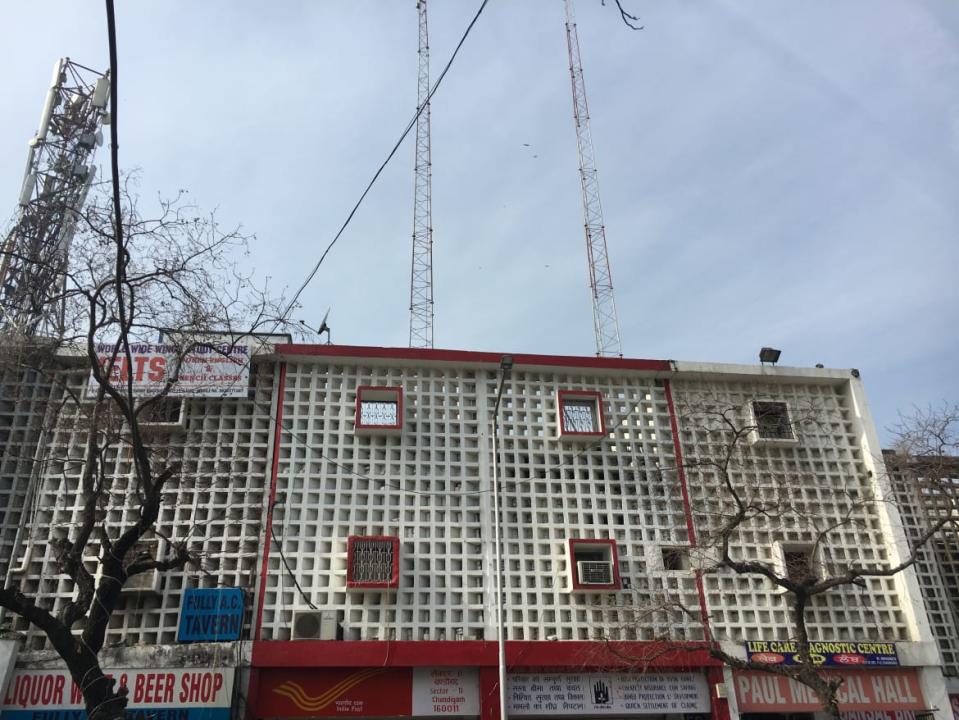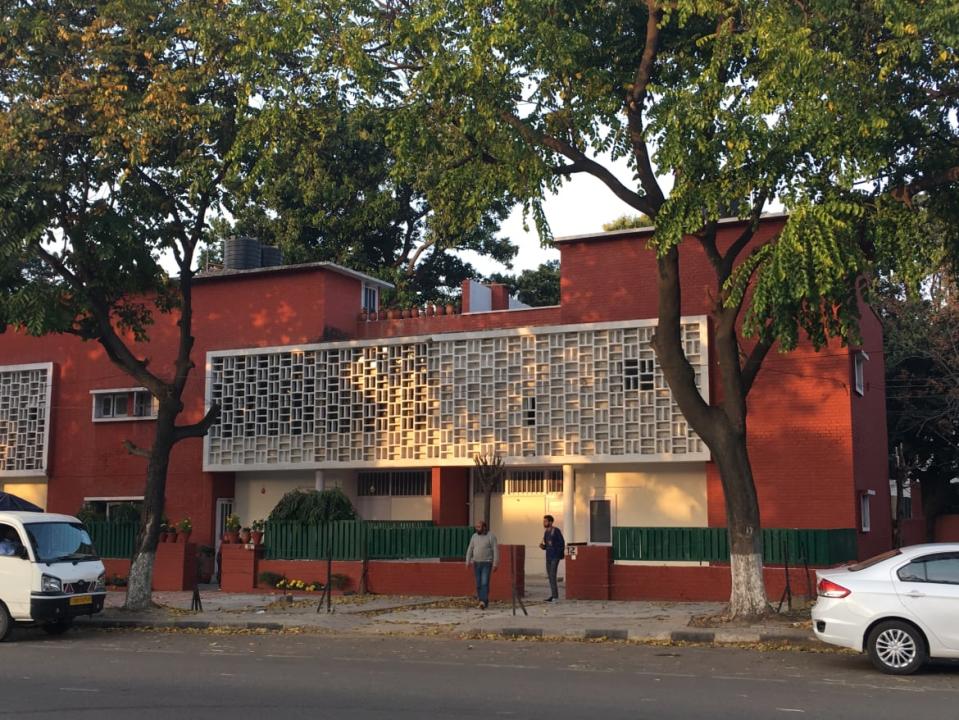The Ultimate City for Modernist Lovers Is in India

You might have heard that Chandigarh is different from other Indian cities, and you weren’t misinformed. Here, about a four-hour train ride northwest of Delhi and within sight of the foothills of the Himalayas, there’s no old city, no Mughal palaces, no timeless temples, no winding streets, or anything of the sort. But you can get those in dozens of other places; there’s only one Chandigarh.
The standard guidebook portrait of Chandigarh—which is always the capital complex designed by French modernist luminary Le Corbusier standing aloof in its plaza—might lead you to think there’s almost nothing there at all. That’s radically untrue. If anywhere nearby make Chandigarh a stop, the distinction of Chandigarh isn’t that it contains a few modern marvels—many near-antediluvian cities do—it’s that it contains hundreds of them, that it is defined by these averages and not these exceptions.

Chandigarh competes only with Brasilia for the distinction of the ur-modern planned city. The city was conceived as a new capital for the province of Punjab, and aggressively encouraged by India’s President Jawaharlal Nehru (it now serves as capital of the since-created state of Haranya as well). The product of an initial plan devised by Americans Albert Mayer and Matthew Nowicki then reshaped by Le Corbusier, the city is a comprehensive collection of modernism.
It’s not quite what you might think though, and often does not resemble the modernism of colder climates. Freed from a need to hermetically seal itself from colder weather modernism loosens up, becomes permeable and often airy. Many structures are colorful; many aren’t concrete, but skillful and varying combinations of brick and stone. If the city’s most famous buildings were by Le Corbusier most were by an unsung but extraordinarily talented international assortment: Le Corbusier’s cousin Pierre Jeanneret, British husband-and-wife team Maxwell Fry and Jane Drew (who had honed their talent for building in warmer climates in West Africa previously), and numerous Indian architects who had their start working on the city, including MN Sharma, Aditya Prakash, BP Mathur, and 2018 Pritzker Prize winner Balakrishna Doshi.
Le Corbusier’s capitol complex is magnificent and obligatory but the rest of the city is a joy to see and experience, a dazzling modern time capsule displaying great ingenuity on literally every sort of structure you would expect in a city, from housing and shops to theaters, swimming pools, and even a roller-skating rink in creative and often exuberant ways. Chandigarh is sure to please any devotee of modernism, but it should be of interest to anyone.

It’s important to emphasize for those who might harbor doubts that while Chandigarh was planned around the automobile, it is not a void of concrete buildings stranded in space. Here avenues are spaces between things, not the only spaces that matter à la Brasilia; it’s a world more walkable than its South American peer. Chandigarh’s grid of autobahn-like main circulatory avenues are somewhat forbidding to pedestrians because traffic moves far faster than on most Indian streets (I have a scar on one hand from a motorbike collision as a warning to greater caution) but the rectangular sectors inside these avenues, which make up the main fabric of the city, are generally very easily walkable, with little traffic and sidewalks in better shape and supply than in most Indian cities.
As for travel between sectors, either take care to cross at roundabouts or summon rickshaws in the small markets at the center of each residential sector.

You will go to the capitol complex, Le Corbusier’s grand experiment and a UNESCO World Heritage Site, purposefully located on the edge of town where he sought to frame the view of the nearby Siwalk foothills of the Himalayas with several new monuments. There are three walking tours daily, originating at the Capitol Complex tourist center on Jan Marg. It’s unclear, like many layers of Indian bureaucracy, whether my advance reservation was necessary or superfluous, but you’d best opt for the advance reservation in any case. My tour group consisted of a German couple and a Keralan high school group; who knows what you’ll find.
A surprisingly short walk, thanks to Corbusian sleight of hand in a “Geometric Hill” designed to withhold the final vista, brings you to the complex’s large plaza. Here there’s the majesty of sublime sculptural experiment: the High Court, where the main functional portions of the building sport a grid of brise-soleil (the sun-shading external patterning around the windows) and appear to have been stapled to the ground by the double roof above, designed to impress for sure, but also to provide a double roof offering a shield from the sun and a space for breeze. The columns which extend to the roof feature pastel shades of green, yellow, and salmon, colors repeated in the brise-soleil, and all actively the reverse of images of the modern architect as severe martinet.

The Palace of Assembly features columns rising to a marvelous curled roof which visually anchors the triangular and cylindrical form of the two legislative assemblies within, and a massive painted ceremonial door designed by Le Corbusier. You will go inside, which requires surrendering your phone but seldom has that sacrifice been so worthwhile. A journey up a series of ramps takes you into a delirious orb of the Punjab Legislative Assembly, with a yellow carpet, green and red seats along still more slopes, and a concave ceiling stretching to a skylight above painted in bands of yellow and red. It’s the opposite of every image of legislative probity you’ve ever held or imagined and entirely magical.
The third building of the complex, the Secretariat, is also impressive, as is the plaza’s iconic Open Hand Monument and the modern folly The Tower of Shadows, designed to provide shifts in patterns of light and dark literally by the minute. Dozens of dogs asleep on the plaza provide a certain levity.
A modest rickshaw ride away are a few more essential Le Corbusier works in Sector 10, also on the north side of the city. The Government Museum and Art Gallery, designed in collaboration with SD Sharma, is stately and designed in a style far different from the capitol complex. There are trademark pilotis raising the building off of the ground, which is designed mainly of brick: inside it’s an extremely airy sequence of ramps, featuring a range of work from Thungka Buddhist paintings to excellent modernism by Shanti Dave, Bhupen Khakhar, and MF Hussein. There’s a splendid ceramic relief by Satish Gujral, a revered Indian artist, near the entrance.
Just across the plaza there is the city’s architecture museum, housed in another Le Corbusier-designed structure, originally a “Pavillion for Temporary exhibits” another concrete structure but this one with a different trick: a series of purposefully narrow passageways and stairs offering a different sort of compression and release and framing a great collection of exhibits on the city’s planning and history, featuring correspondence, diagrams, a striking Le Corbusier Modulor model, and swank wooden furniture by Pierre Jeanneret. Especially interesting is content on one unbuilt Capitol Complex structure, a Governor’s Palace, which came nearest to reality in models and sketches here.

Adjoining these is the single-story Le Corbusier-designed Government College for Art, an agreeable highly perforated one-story structure ringed by student work and sculpture. Nearby you can see the work of the one Indian female architect working on the project, in the Home Science College for Girls. Chowdhury was the one project architect fluent in French and an invaluable conduit for Corbusier. If you’re in the mood for something more lighthearted MN Sharma’s roller skating rink is also nearby in the sector.
You cannot live on museums alone, or in museums alone. The older residential sectors of the city are among its most pleasant, and they are very very far from austere modern stereotypes, consisting generally of lovely villas or smaller buildings, many of which aren’t built of concrete, and frequently containing ample color. The eastern sectors of the city (the lowest numbered) contain its lowest-scale housing for government grandees or the wealthy and are ideal for gawking rambles.
The recently-opened Pierre Jeanneret Museum in Sector 5, housed in his own house is a must-see. Jeanneret was part of the Le Corbusier cousin package deal for the Indian government; he lived in the city for 15 years, long enough to design his own home, which opened as a museum in 2018 and offers a welcome chance to get inside one of the many superb modern homes in the city. It’s an airy home full of fine details. Perforated red brick screens are inset in white walls with two grey stone accent walls. The interior is full of quirky details: a spiky spiral staircase; irregular portholes, sudden shifts in brick, and more. The interior is filled out with quality Jeanneret furniture.
A Jeanneret quotation on one wall signals your best approach to the city: “What are our new towns composed of? Of small houses and small buildings which cover the majority of its area.Therefore it is also for these small buildings that it is necessary to take the greatest care for the aesthetic sense.”
Several more of Jeanneret’s wonderful small buildings are close by, the PL Varma and ID Oberoi residences, which continues his simple but elegant experiments wielding contrastive white stone and red brick. There’s another of his homes, the Mrs. Nirlep Kaur house in Sector 4, along with flats for members of the Punjab Legislative Assembly by Jeanneret and excellent Judges Houses by Maxwell Fry. TK description. Sector 3 offers more Jeanneret, with his MLA hostel and MLA flats. These are similar exercises in brick and stone, with contrastive colors a constant feature. Sometimes white stone will provide structure and brick ornament, sometimes the reverse; it’s easy to permeate a wall whenever the architect pleased: to then throw on a ramp or slant a diagonal is also simple: constant variety attends all of this work.

Now one self-evidently valid criticism of Chandigarh is that it isn’t dense enough. Last year I had occasion to ask Balakrishna Doshi, the prominent Indian architect, his opinion of the city and he responded negatively, that “I think the densities are not there.” He noted, however, “Sector 22, the first one, is the one I like. It’s very intimate, the bazaar-like quality is more public in that sense.”
Sector 22 is still unmistakably modern but it is dense and lively in ways reminiscent of traditional Indian cities, containing a multitude of excellent middle income apartment blocks and public buildings. Fry designed its commercial center, Jeanneret the secondary school. Fry’s Kiran Cinema, featuring a double-roofed facade lined by blue tiles is great. The adjacent Sector 23 is quite similar—walk around! The variations upon a theme the city’s architects employed are unfailingly impressive, and here a rejoinder to dull low-budget architecture the world around.
The city’s commercial center, Sector 17 might not be to all tastes: this is the one place in the city where a palate of concrete might loom a bit monotonous. There’s also an element of dilapidation here that you don’t find in much of the rest of the city. It’s still a fascinating place, full of colonnaded commercial buildings by Le Corbusier. Escape grayscale inside Aditya Prakash’s Neelam Cinema features a captivating blue tile interior accentuated by steel decorative panels. Jeanneret’s Central State Library features curves and Corbusian splashes of color inside. Jeanneret’s town hall is stately: don’t miss the lineup of Sikh notaries attending to their typewriters outside. The geometrically gripping fountain by MN Sharma is excellent.
This seems an apt time to mention something you likely won’t find in the center of Chandigarh, or anywhere else in town, which is the relentless offers of services or trinkets that anyone who looks too obviously like a tourist is likely to find in more popular Indian travel destinations. The sole commercial entreaty I received was for a shoeshine; one local seemed bemused as to why I would be photographing buildings in the center; he declared himself pleased.
A few other sectors in the North overflow with standout architecture. Sector 14, which contains the Panjab University Campus is great for a walk: see the Gandhi Bhawan and the A.C. Joshi Library by Jeanneret. The ovoid student center by Mathur is also excellent. Modern American dormitories are generally horrible: contrast these with smart residences here. This sector is easy to walk around, with plenty of greenery and shade, and lively student life.
Farther afield but very much worth a look is Le Corbusier and Prakash’s College of Architecture, a single story structure built mainly of brick with a facade that is entirely vented, a superb incubator for that activity if there ever was one.
To the south of the city there’s the Corbusier Center in sector 19, housed in the former home of the city architect’s office. It features a small collection containing correspondence and models resembling the architecture museum but worth a visit in its own right, along with an extremely economical gift shop.
That’s only a sampling: if you liked any of the sectors above you’ll probably like the ones next to them. Any of the older sectors are worth a look: in general the sectors of the city completed later on the city’s western edge can likely be skipped, but there’s meritorious work from the 1970s in Sector 43 and 44 as well.
If you tire of this nature is never far-away. There are parks, some of considerable size, in every sector, and there’s a park belt of “leisure valley” running through the city. Nek Chand Saini’s Rock Gardens are not far from the city. Sukhna Lake, south of the capitol complex, offers unobstructed Himalayan vistas and boating, with better-than-average aquatic facilities designed by Jeanneret and Corbusier.
There are conjoined glib tendencies to declare Chandigarh a foreign imposition and unworkable, the first of which is radically untrue and the second of which is still largely false. MN Sharma, who worked at length on Chandigarh responded to a question about the “foreign” origins of Chandigarh by noting that the Taj Mahal was a symbol of Persian conquest, but is now the best known symbol of India the world over. Le Corbusier did not come to conquer but rather by warm invitation, and it was Nehru’s request for buildings “unfettered by the traditions of the past” that resulted in this city.
Not to mention, it was built in considerable part by native architects, who deserve more credit than they’ve received and whose work stands at the origins of an excellent strain of modernism that came to flourish in India as its own accomplishment. To be sure there are some buildings that aren’t ideally adapted for local circumstances, but most are. The city’s orientation around the automobile, if not complete, is excessive, and its rigid planning left little room for the mixture of commercial and residential uses that characterize most of Indian society. The city also left literally little room for growth and has become surrounded by sprawl and slums like any other Indian city. Were you to design a city again, you wouldn’t do it this way.
Yet it is a fascinating time capsule of design that does work: it is the residents of this city that demonstrate that, with problems, it unquestionably does function. Some are drawn to the city for its modern qualities, many more simply because offers space and excellent homes and many other qualities. It also offers a great number of things to see. Le Corbusier wrote “It provides us with places and buildings for all human activities by which the citizens can live a full and harmonious life. Here the radiance of nature and heart are within our reach.” Within your reach also perhaps, just a short train ride from Delhi.
Get our top stories in your inbox every day. Sign up now!
Daily Beast Membership: Beast Inside goes deeper on the stories that matter to you. Learn more.

